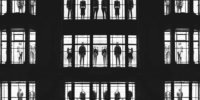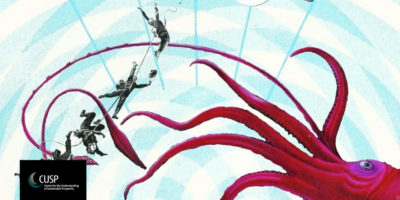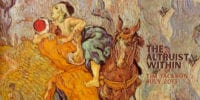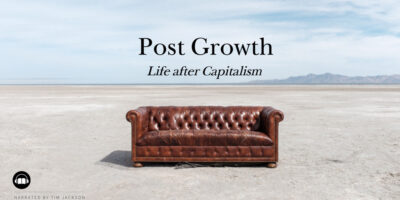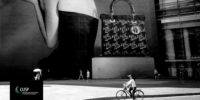Echoes of immortality: Art and the Wellbeing Economy
A talk delivered by Tim Jackson for the Wellbeing Economy Alliance Ireland Hub, launching the Community of Practice for Artists and Creatives, March 2023.
By Tim Jackson
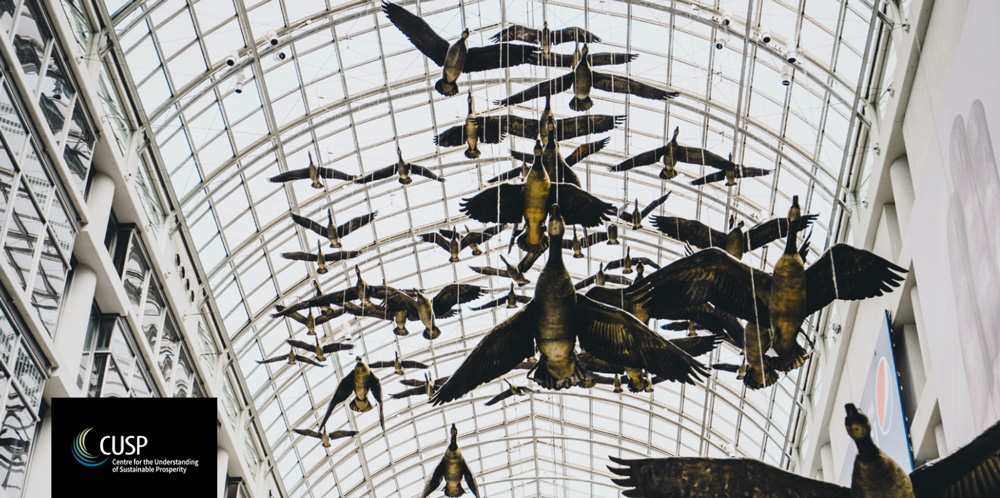
‘When the moon rises,’ said the Spanish poet Federico García Lorca, ‘the sea covers the land and the heart feels like an island in the infinite’. Children understand this feeling, ‘look, look, it’s the moon’ they cry, ‘the moon’. They turn their own moon faces up towards you with delight and trepidation finely balanced. ‘Look at the moon daddy.’ Who are these children? you ask yourself, Where do they come from? The truth is that they are strangers visiting us from another country. It’s called the future. ‘Your children are not your children,’ said Kahlil Gibran, ‘you may house their bodies but not their souls, for their souls dwell in the house of tomorrow. Which you cannot visit, not even in your dreams.’
A few years ago I was installing some insulation in our home on a Sunday afternoon and my daughter, who was young at the time, was helping me. We were pressing thin strips of adhesive-backed foam into the corners of windows and doors to keep out the draughts. At least that’s what I was doing. She was doing something else. ‘Will this really keep out the giraffes?’ she said. You can hear the five-year-old mind at work. How did they get into our garden? Can this tiny strip of plastic really keep them out because everyone knows how tall and thin they are. They can probably squeeze through the tiniest cracks and what will happen if they do? Will they tangle us up in gangly limbs at breakfast time.
What kind of cereals do giraffes eat anyway? And ‘Will I meet them on my way to school.’
My daughter was a Millennium baby. She has a certificate from the Queen to prove it. Her age will always track the passing years of the 21st century. How old will you be in 2050? She will be fifty. It’s her century. The one in which the climate and many other ecological battles will either be won or lost. Her class held up placards back in the noughties when the UK led the world on climate legislation. ‘It’s our planet.’ But where are we now? What will it look like in 2050? Will there still be giraffes on it?
These are her questions and mine.
I’ve thought a lot about those giraffes. At first I mistook them for a childish interpretation of a weekend chore but with Kahlil Gibran’s help and the memory of my daughter’s moon face raised inquiringly I see I was mistaken. The giraffes are there, they really are in the garden. The task is real. Keeping out the giraffes matters.
There are lots of puzzles in our failure to combat climate change. One of them is the many easy things we routinely fail to do about it, like draught stripping for example. Insulating our homes becomes unassailable, it makes absolute sense. In the midst of a ‘cost-of-living’ crisis it makes even more sense, saves us money, lowers our carbon, reduces our exposure to Putin’s aggression, it makes our lives safer and more comfortable. And yet they don’t get done these simple things. Time and time again. The technologies work. The economics are favourable. The results are demonstrable, but our political attention is missing or our priorities are elsewhere. Climate is the bottom of our list. Rainforests are a long, long way from here.
Our lives instead are taken up with daily tasks. Putting the kids on the bus. Getting to work on time. Surviving shop floor politics and e-mail overload. Foraging for groceries. Throwing together meals. Binging on Netflix. Collapsing into bed. Eat. Sleep. Repeat. We count ourselves lucky to make it from one end of the day to another, locked in routine, lost in anxiety, striving for status, keeping out the giraffes. For everyone knows and instinctively fears the havoc that long-necked creatures wreak when they slip through the cracks in our lives.
That isn’t all there is of course. Our lives routinely rise above routine. Relationships matter. Family matters. Hope for the future matters and we constantly strive to keep those hopes alive. The daily grind is lifted from obscurity by the colour of our dreams, our aspirations soar on rainbow wings. We continually crave a better life for ourselves and our children.
Occasionally we escape into moments of unadulterated pleasure and from the loose fabric of fantasy and the radiant colours of desire we create and maintain a sense of meaning and purpose in our lives.
‘What is the objective of the consumer?’ asked the anthropologist, Mary Douglas, in an essay on poverty written over 30 years ago.
It is to help create the social world, she said, and find a credible place in it. This deeply humanising vision of consumer lives is also a forgiving one. We would like to condemn materialism as greed and damn consumerism to hell but in the same token we are locked into its social logic by our own symbolic attachment to stuff. Matter matters to us and not just in functional ways. Beyond the immediacy of material sustenance, food, clothing, shelter…consumer goods provide a kind of language through which we communicate. We tell each other stories through material things and with those stories we create the narratives that sustain our lives.
This task—and I’m coming to the point now—is a fundamentally artistic one.
Technology is important to its functionality. Science furnishes the understanding. Artefacts offer a language. Goods and services provide what Amartya Sen called our capabilities for flourishing. But the task itself is an act of creation, a creative gesture. It calls on our imagination, our hopes, our vision. It engages our values, our identity, our sense of shared humanity. Society hangs on the gossamer thread of collective dreams. It always has done. Living is an artistic endeavour. That’s my point. Art doesn’t portray life. Life doesn’t imitate art.
Life and art play endless swing ball in each other’s backyard.
The uniquely human adaptation of artistic expression is as strong a force in our shared history as were the steam engine, the semiconductor, and the Internet. Infinitely more so, the stories we told, the visions we saw, the dreams we shared—these were the building blocks of civilization, the harbingers of progress, the bringers of hope.
In making this claim I’m not attempting to privilege artists. Art and celebrity are crudely intertwined in the modern mind. But celebrity isn’t the essence of art, just its expression in a confused culture adrift from its moorings in shared meaning. Nor am I trying to suggest that art can rise above our culpability for ecological change. That would be ridiculous. The hands of the artists are stained with the blood of empire. The lifestyle of a successful popstar can beggar the carbon footprint of a Sub-Saharan nation. Art miscatalogued too many abuses and stood silent through too many atrocities. But it also suffered those atrocities. It bore witness to the cruelty that people inflict on one another. It gave voice to the oppressed, spoke up for the dispossessed, it understood our joy and commiserated in our sorrow, whispered to us in our own language.
The heart has reasons reason does not know at all, said the French philosopher Pascal. Art speaks to and from the heart. In its purest form the artistic endeavour is a form of creation—one that we are all engaged in.
I think I probably came to this realisation early on in my life. The written word for me was an escape from the voluble relatives whose conversation I could barely puncture with my half-formed hopes and dreams. Writing plays was a way to tame that volubility and make a kind of sense of it. Telling stories was a way of living life to the full, connecting with the experiences of others, journeying along the road less travelled. But almost as soon as I had set out on it, I was called away from the task by a calamity that drew me out of my day dreams and into the immediacy of the world. The meltdown of reactor number four in Chernobyl, in April 1986, was a wake-up call to the aspiring playwright hoping for fame.
My parents had dragged me to CND rallies to protest against nuclear weapons. But the dangers of civil nuclear power brought home to me the Leviathan power of runaway technology. The next day I walked into the offices of Greenpeace in London and asked them to find me something to do. They set me working on the economics of renewable energy and overnight I became an accidental economist. And since that moment I’ve looked up from that task barely long enough to write a few more radio plays and to insulate a few kitchen doors of course.
That journey took me not to London’s West End but briefly at least to Westminster’s inner sanctum when I was appointed as economics commissioner on the Government’s Sustainable Development Commission where I wrote a book that effectively put paid to my play-writing career. For now. I’m not going to say for good. But the last decade has been an extraordinary rollercoaster through one of the most painful conundrums of our time: what I call the dilemma of growth, a kind of ‘can’t live with it can’t live without it struggle’ to imagine a different kind of economics informed by a different vision of progress.
Prosperity without Growth was not a work of art. I like to think it’s reasonably well-written of course but its intended audience was policy-makers. In fact in its original form it was a report to the British Prime Minister at the time. The first ever such report to a standing premier that dared to question the shibboleths of growth. And I think my working assumption was that if I made it as accessible as possible and as logically coherent as I could, the force of its arguments would carry the day, the policy proposals would be adopted and things would change. Call me naïve. In retrospect I was. I got a glimpse of that when, the day before the report was launched, I received a phone call telling me that Number 10 [Downing Street] had gone ballistic. This, it seems, was not the way to win friends and influence people. But in the intervening years I’ve been surprised and humbled by the number of people Prosperity without Growth did reach, way beyond the intended audience. And I’ve also had to watch in horror as its recommendations were ignored over and over again.
I began to realise, or perhaps to remember, that logic does not always carry the day. The heart has reasons reason does not know at all.
And when I sat down in the early months of the pandemic in 2020 to write another book, I realised it had to be not so much a sequel as a prequel to the earlier one. A more philosophical piece, telling the human stories of those whose work had inspired my own work and those whose vision might inspire all of us to imagine a better world. “Economic wisdom wrapped up in poetry” was one of my favourite reviews of the book at the time.
Post Growth: Life after Capitalism allowed me to connect with the playwright inside. It reminded me of the power of human story in the task of collective imagination. It’s too early to say whether Post Growth will be more successful than Prosperity Without Growth in changing the political agenda but it’s clear that any attempt to change our world must recognise a fundamental truth: it must speak a language people understand. Science can sketch the nature of the problem. Technology can facilitate the solutions. Economics can point out the costs and benefits. Art engages the soul. It speaks to the moonstruck child in us. It whispers to the giraffes. Art looks like the perfect addition to our instruments of change.
And yet I want to resist the call to think of art this way.
Perhaps art can succeed where policy fails, perhaps we can sketch and compose and sculpt our way towards a wellbeing economy. Perhaps celebrity artists can lead us by example towards sustainability. But this line of thinking falls into too many traps: that art has traction in politics, that poetry speaks truth to power, that art is instrumental at all. Some of these things may be partially true but the biggest danger of all lies in subjugating artistic endeavour to reason. Because doing so risks robbing art of meaning. And meaning is something I suspect we’re going to badly need in the times to come.
Instead I want to propose that we keep art free to play a far more vital role in the emotional fabric of our lives. Three roles in fact: vision, resolution and consolation. Let me finish by speaking briefly about each of these. I’m fascinated by the proliferation of post-apocalyptic visions of the world: from Russell Hoban’s Ridley Walker, to David Mitchell’s Cloud Atlas, from Saci Lloyd’s Carbon Diaries to Will Self’s Book of Dave. And perhaps most poignant of all, dark though it is, Cormack McCarthy’s elegiac novel, The Road. Literature is replete with memories of the future. And the astonishing thing is that even for someone like me—who has worked for over three decades in the science of the future—those stories have an extraordinary and unexpected power. They connect me to tomorrow in a way that scenario models somehow fail to do. Perhaps even more striking are the visions of our inner world. I think for instance of Rembrandt’s Allegories, Chopin’s Nocturnes, Rodin’s sculpture. In Rembrandt’s iconic Return of the Prodigal Son, the father’s strangely feminine hands rest on the shoulders of the returning son whose torn and tattered garments somehow radiate a golden light. In an amazing early pencil sketch of the roadside scene in the parable of the Good Samaritan, he offers an extraordinarily intimate portrait of the altruist within us all. Beneath the noise of human strife, Rembrandt reminds us, lies a fragile interior space worth knowing about, worth protecting.
These visions are not always comfortable. They are not without conflict and suffering. And here is another of art’s lessons. As an environmentalist I’m struck by our professional tendency to try and flatten the conflict landscape, to want to rush immediately to the promised land. But as a playwright, I’m acutely aware of the rules of the game. The essence of drama is conflict. The arc of the story requires a protagonist, a call to arms, a quest, a series of trials, a reversal, transformation, and a journey home. Resolution through conflict.
Art pays homage to the nature of the journey, its sense of struggle, the power and partiality of resolution. Not as an instant comfortable future but as a goal hard earned, easily lost and almost always temporary.
There are lessons here for the wellbeing economy, for all of us.
When the moon rises, said Lorca, the bells hang silent and pathways appear impenetrable. The way ahead is gone. Our children turn to us and ask ‘Where now?’ ‘Which way do we go?’
What would it take for us to admit that we don’t know the answer, that we’re lost, that our best attempts to combat climate change have failed, that our economies are bankrupt, that our technologies are broken, that our politicians have let us down, that restraint lost its fight with desire. Justice its struggle against inequity. That our vision of progress was an illusion, a dream we once had, a story we told our children to stop them getting frightened by the moon. This is where we need the consolation of art. Its understanding of sorrow, failure and loss. Its intimations of transcendence.
Nobody eats oranges under the full moon, said Lorca, who would die a few years afterwards at the age of only thirty-eight from an assassin’s bullet. One must eat fruit that is green and cold. You’re not alone in fear, he says. And in the same breath intimates that the time for oranges will come again. Loss is only part of the arc of the story. Reversal is only temporary.
Art teaches us to look beyond the glitter of triumph and the shadow of disaster and to detect beneath them the intimations of immortality.
Vision, resolution, consolation. These are the tools from which to build a different future, our ability to live well, to flourish in less materialistic ways, is in its essence an artistic endeavour.
Sustainability is the art of living well within the ecological limits of a finite planet.
Art is more than an instrument in this project. It’s the very nature of it.
So let me just finish by thanking you again for inviting me today and by encouraging you to see your work in this project over the next years not as an adjunct to the technical change or economic reform that we so badly need but as the very heart of the transition to a wellbeing economy.
Thank you.

